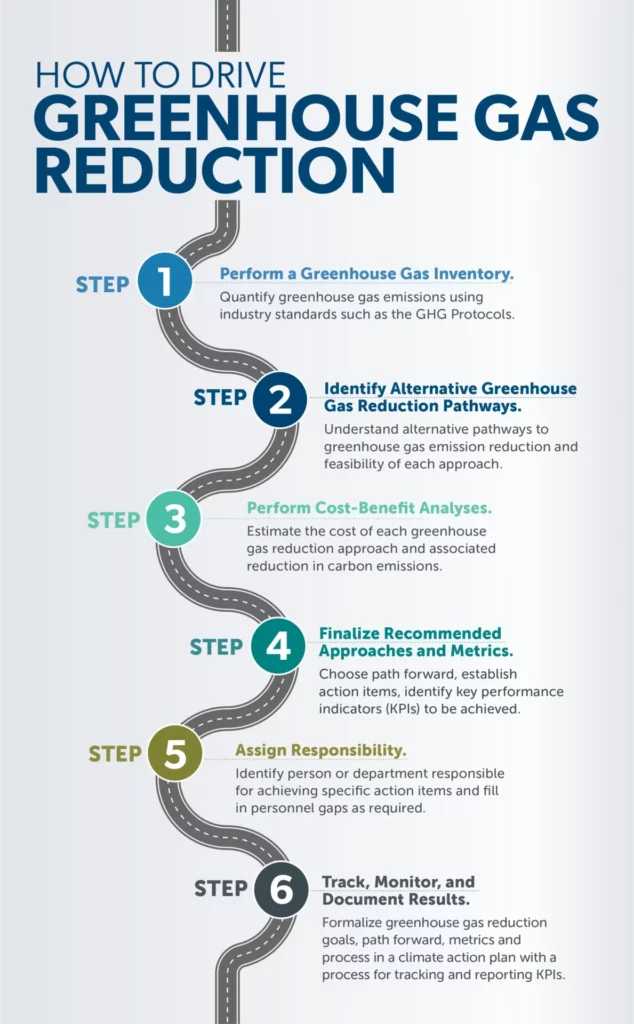Large corporations, state governments and localities are issuing press releases and public statements concerning their greenhouse gas reduction goals. Some are aiming for 100% renewable energy, others have established net zero goals, and strive for emissions-free operations. With new and forthcoming disclosure rules in the U.S. and internationally, these destinations need a well thought out implementation plan.
Although most of these goals establish a future year for achievement – usually somewhere between 2035 and 2050 – reporting rules require near-term updates. For those companies who have yet to issue their own greenhouse gas reduction goals, it is useful to start assessing the different paths forward while reduction efforts are still voluntary. Although such targets may seem to be decades away, regulatory requirements and reputational integrity warrant timely action and regular progress reports.

Set Your Starting Point
For those who have not established or declared a greenhouse gas emissions reduction goal, you still can decide how to move forward with an understanding of what such a commitment might entail. In general, organizations have two logical starting lines:
- Announce a goal and then plot the best roadmap for meeting that goal; or
- Understand costs and benefits or alternative paths and timeframes to identify the best goal for a given roadmap.
Companies that have announced their voluntary goals may suddenly find themselves subject to a regulatory roadmap with statutory requirements tied to those goals. Companies that contemplate their journey in the context of existing or future requirements may have more flexibility in plotting their path forward. In today’s environment, however, where most companies are likely to be captured by a widening set of legal, regulatory, and market-based requirements, assessing your position and anticipating your next step is likely to prove useful.
Regardless of whether or not a company has declared their greenhouse house emissions reduction goals, the changing regulatory climate is going to require a tailored implementation plan to a company’s resources and needs. As such, gathering information to set forth the right implementation plan requires an analytical exercise by someone familiar with energy resources, carbon content and accounting, business operations, corporate investigations, and realistic alternatives. In today’s rapidly changing regulatory climate, even a decision to defer engaging in emissions reductions requires analysis of the potential costs and benefits.
Delineate Your Destination
The destination should be based on your reason for pursuing greenhouse gas reductions. Trying to achieve something that is inconsistent with corporate culture or ideals will be difficult, even in the face of regulatory and market expectations. Although the ultimate destination may be a clearly defined goal such as 100% renewables by 2030, net zero by 2040, and zero or negative carbon operations by 2050, the overarching objectives may be even more important.
There are a number of potential objectives for pursuing environmental goals, including:
- Regulatory Compliance – At a minimum, organizations need to meet regulatory requirements in jurisdictions where they operate.
- Maintaining Market Share – Status quo requires being in line with competitors and responding to existing customer demands.
- Competitive Advantage – Organizations may have the opportunity to gain a competitive advantage through their climate actions.
- Transformation – Incorporating environmental protection into your organization’s corporate purpose can unlock value in new ways.
As with any journey, the destinations can evolve over time.
Choose Your Travel Companions
Greenhouse gas reduction goals can be set by any entity or group of entities that generate emissions in its day-to-day operations, whether individual, community, corporate, government or multi-country organizations. In the United States, corporations and state/local governments are taking the lead in setting target dates and developing climate action plans on how to achieve those goals. Even companies that are heavily dependent on fossil fuels are making public declarations that their dependence on greenhouse gas-emitting resources has a finite timeframe. Additionally, many are starting to require their vendors to do the same, or at least favor vendors who have a greenhouse gas reduction program, climate action plan, or stated sustainability goals already in place.
Evolving technologies and new entrants are enablers, along with internal and external resources. As with any journey, choose your travel companions wisely.
Recognize the Right Road
There are many different paths to get to the same destination. In the case of greenhouse gas reductions, the focus for power-intensive industries may be to rely solely on renewable resources. For organizations that cannot operate without emitting greenhouse gases due to technological limitations, the optimal solution may be going net zero, where greenhouse gases are offset by carbon capture or credits. Some organizations may be in a position to operate at zero or negative emissions, where they operationally offset more emissions than they produce.
Achieving greenhouse gas reductions is a process, and therefore best implemented through process optimization.
Map Your Milestones
Your journey is likely to follow a path or roadmap with the following milestones.
- Step 1: Perform a Greenhouse Gas Inventory. The first step is understanding where your organization stands today. The starting point is a greenhouse gas inventory – understanding your organization’s greenhouse gas emissions as an output of production and measuring it using generally-accepted metrics and tracking tools. In general, greenhouse gas emissions occur due to energy use, with the major inputs of production being electricity, buildings, transportation, waste and nature. If your organization has announced greenhouse gas reduction goals, you already know your destination and estimated time of arrival. If your organization wants to explore the alternatives, you still need a starting point.
- Step 2: Identify Alternative Greenhouse Gas Reduction Pathways. Reducing your organization’s greenhouse gas emissions generally can be achieved by implementing business processes, technology, education, and human behavior. Exploring different ways to achieve reductions in different timeframes can vary these levers. With a multitude of alternative approaches available to most companies, it is important to work with the organization to determine which can be politically, financially and socially feasible.
- Step 3: Cost-benefit Analyses. With feasible pathways identified, a subset of the alternatives can be assessed using cost-benefit analyses that estimate an implied “price” for greenhouse gases. Assessing the “price” for greenhouse gases includes the estimated cost per ton of greenhouse gas reduction, but also should extend beyond financial considerations to encompass a qualitative assessment of cultural and corporate realities.
- Step 4: Finalize Recommended Approaches and Metrics. Based on Steps 1 through 3, recommended pathways can be specified along with metrics to be achieved.
- Step 5: Assign Responsibility. Achieve accountability by assigning responsibility to individuals and groups who can bring the recommended goals to fruition. A Sustainability Executive or Director may be hired to lead a corporation’s greenhouse gas reduction efforts, but specific parts of the organization have more direct operational control and decision-making authority to implement identified approaches. The process of measuring greenhouse gases and identifying approaches should have included those likely to be responsible from the beginning so as to create a sense of ownership and responsibility; operational responsibilities should not be a surprise.
- Step 6: Track, Monitor, and Document Results. The process towards defining the approach to achieve net zero and its final results should be documented in a formal document such as a climate action plan or pathways to net zero with regular updates. Documenting the path forward formalizes the goals and provides a means of communication and ongoing monitoring of the implementation process. Establishing a process for tracking and reporting facilitates compliance with greenhouse gas emissions reporting requirements, whether due to regulations or competitive requirements.
Enjoy the Journey
Whether setting greenhouse gas emissions reduction goals or developing a path to get there, realize the following:
The journey is the destination;
There may be many destinations; and
The path is iterative.
Reducing emissions can be just as effective whether implementation is treated as a compass heading or a set of coordinates. How to proceed depends on the specifics of your situation. Regardless of your starting point, destination, traveling companions, path forward, and approach taken, it is important to examine alternative paths forward that are achievable and realistic for your organization.
With a plan in place, leadership approval and organizational buy-in, implementation can begin. However, that is an entirely different journey.







